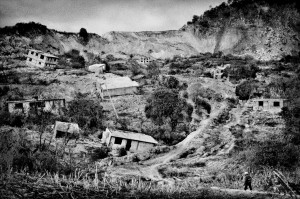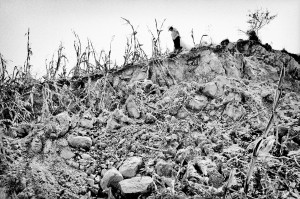22 May MOUNTAINFILM’S GALLERY WALK: MATT BLACK AT LA COCINA

Houses drift downhill in a slow-motion landslide. Santiago Mitlatongo, Mexico.
To call Mountainfilm in Telluride a film festival is less a misnomer than an understatement. Now celebrating 35 years, Mountainfilm includes, but is not limited to, films about mountain living and adventure, remarkable places, endangered peoples and ideas. The catchall celebration also features breakfast talks, panel discussions, and book-signings.
Mountainfilm’s official kick-off is the Gallery Walk, Friday, May 24, 3:30 – 6:30 p.m. at venues all around town. It’s a party with free drinks and hors d’oeuvres that features exhibitions of paintings, drawings, and photography such as that of Matt Black, whose austere visual poems are on display at La Cocina de Luz in a series he entitles “After the Fall.”
To look at a photograph is to enter into a relationship that allows us to learn about the photographers’ view of the world. (And through that relationship, we might learn something about ourselves.) Matt’s view of one particular corner world seems clear: he is outraged and compassionate – though not overtly sentimental, in keeping with the documentary tradition of photography.
Matt follows hard in the footsteps of the great photographers of the Dust Bowl of the 1930s, among them, Walker Evans – the godfather of the documentary tradition – Dorothea Lange, and Arthur Rothstein, who recorded the human, natural, and economic devastation of the Southern and Central Great Plain during the Great Depression.
For over a decade, Matt has been traveling back and forth between indigenous tribes of southern Mexico and the Central Valley of California, documenting the effects on these rapidly changing cultures and economies. The work chronicles how environmental degradation, the economic impact of free trade, and social dislocation that stems from migration are decimating one of the world’s last bastions of traditional indigenous life in Mexico’s once storied Mixteca region.

Harvesting a wrecked corn field. Santiago Mitlatongo, Mexico.
“Looking at half-deserted villages surrounded by cornfields eroded down to bedrock, it’s hard to imagine that the Mixteca was once a jewel of Mesoamerica,” Matt wrote. “But this region once sheltered one of the most advanced cultures in the Americas, the only one in the Western Hemisphere with a written history dating back over a thousand years. The birthplace of hundreds of varieties of native corn and some of pre-Columbian Mexico’s most storied fighters, the Mixteca grew into such a powerful region that it was one of the few Mexican kingdoms never to be fully subjugated by the Aztecs. Mixtecapan, they called it: ‘Place of the Cloud People.'”
Today, the “People of the Clouds” are drifting away; what little that remains of their civilization now just tumbling down a hill.
“Few see much future in a place that has lost up to five meters of topsoil to runaway erosion, leaving over 1 million acres so severely damaged that the UN now calls the region one of the most heavily eroded landscapes in the world. One of the oldest continually cultivated patches of ground on earth, tended by one of the world’s oldest farming cultures, is becoming little more than a vacant wasteland,” continued Matt.
Is history repeating itself? Ashes to ashes… dust bowl to dust bowl.
Matt Black grew up in a small town in California’s Central Valley, a vast agricultural area in the heart of the state. He started photography at a young age and worked as a newspaper photographer while in his teens. Matt attended San Francisco State University, where he studied Latin American and U.S. Labor History. His work has been widely honored with awards from the World Press Photo Foundation, the Alexia Foundation for World Peace, the Robert F. Kennedy Memorial Foundation and others.
To learn more about Matt and “The People of the Clouds,” click the “play” button and listen to our conversation.


Sorry, the comment form is closed at this time.